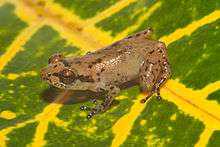Diasporus
Diasporus is a genus of frogs in the family Eleutherodactylidae. The genus was first described in 2008.[1][2] They are found in Central and northern South America. They are sometimes referred to as dink frogs,[2] in reference to the "tink" sound that males make during the mating season.[3]
| Diasporus | |
|---|---|
 | |
| Diasporus diastema | |
| Scientific classification | |
| Kingdom: | Animalia |
| Phylum: | Chordata |
| Class: | Amphibia |
| Order: | Anura |
| Family: | Eleutherodactylidae |
| Subfamily: | Eleutherodactylinae |
| Genus: | Diasporus Hedges, Duellman, and Heinicke, 2008 |
| Type species | |
| Lithodytes diastema Cope, 1875 | |
| Species | |
|
See text | |
Characteristics
Diasporus are small frogs, with a snout–vent length varying between 11 mm (0.43 in) in male Diasporus quidditus to 26 mm (1.0 in) in female Diasporus hylaeformis. They have a relatively large, distinct head. All members have direct development, skipping a tadpole stage.[1] The male advertisement call is either a "whistle" or a "tink" (or "dink"), depending on the species.[4]
Etymology
The name is from the Greek diaspora ("a dispersion from"). It refers to the relationship of this genus to the Caribbean clade of Eleutherodactylus.[1]
Distribution
Diasporus spp. inhabit humid lowland and montane forests from eastern Honduras through Panama to the Pacific versant of Colombia and northwestern Ecuador.[1][5]
Species
The following species are recognised in the genus Diasporus:[2][6]
- Diasporus amirae Arias, Chaves, Salazar, Salazar-Zúñiga, and García-Rodríguez, 2019
- Diasporus anthrax (Lynch, 2001)
- Diasporus citrinobapheus Hertz, Hauenschild, Lotzkat, and Köhler, 2012
- Diasporus darienensis Batista, Köhler, Mebert, Hertz, and Vesely, 2016
- Diasporus diastema (Cope, 1875)
- Diasporus gularis (Boulenger, 1898)
- Diasporus hylaeformis (Cope, 1875)
- Diasporus igneus Batista, Ponce, and Hertz, 2012
- Diasporus majeensis Batista, Köhler, Mebert, Hertz, and Vesely, 2016
- Diasporus pequeno Batista, Köhler, Mebert, Hertz, and Vesely, 2016
- Diasporus quidditus (Lynch, 2001)
- Diasporus sapo Batista, Köhler, Mebert, Hertz, and Vesely, 2016
- Diasporus tigrillo (Savage, 1997)
- Diasporus tinker (Lynch, 2001)
- Diasporus ventrimaculatus Chaves, García-Rodríguez, Mora, and Leal, 2009
- Diasporus vocator (Taylor, 1955)
References
- Hedges, S. B.; Duellman, W. E. & Heinicke, M. P (2008). "New World direct-developing frogs (Anura: Terrarana): Molecular phylogeny, classification, biogeography, and conservation" (PDF). Zootaxa. 1737: 1–182.
- Frost, Darrel R. (2017). "Diasporus Hedges, Duellman, and Heinicke, 2008". Amphibian Species of the World: an Online Reference. Version 6.0. American Museum of Natural History. Retrieved 10 June 2017.
- "Just calling for a kiss. Cute Frog of the Week: January 2, 2012". Panama Amphibian Rescue and Conservation Project. 2 January 2012. Retrieved 24 September 2014.
- Toro-Sánchez, Tatiana & Bernal-Bautista, Manuel Hernando (2015). "The advertisement call of Diasporus gularis and D. tinker from the Pacific Region of Colombia". South American Journal of Herpetology. 10 (2): 116–120. doi:10.2994/SAJH-D-14-00041.1.
- Hertz, A.; Hauenschild, F.; Lotzkat, S.; Köhler, G. (2012). "A new golden frog species of the genus Diasporus (Amphibia, Eleutherodactylidae) from the Cordillera Central, western Panama". ZooKeys. 196: 23–46. doi:10.3897/zookeys.196.2774. PMC 3361085. PMID 22679389.
- "Eleutherodactylidae". AmphibiaWeb: Information on amphibian biology and conservation. [web application]. Berkeley, California: AmphibiaWeb. 2017. Retrieved 10 June 2017.